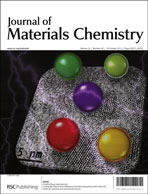An aqueous solution process and subsequent UV treatment for highly transparent conductive ZnO films†
Abstract
High electric conductivity was achieved in ZnO films prepared by a low-temperature (<100 °C) wet-chemical process and subsequent UV treatment by a commercial blacklight-blue lamp with a central wavelength of 360 nm and output power of 2.0 mW cm−2. The UV treatment to the as-deposited film successfully decreased the electric resistivity of the film by three orders of magnitude from 11 to 4.4 × 10−3 Ω cm. The resistivity was not restored to the initial value even after dark storage for 50 days, indicating that the decrease of the resistivity has not mainly originated from conventional persistent photoconductivity. The results of Hall measurement and Fourier transformed infrared measurement showed that an increase of carrier concentration and


 Please wait while we load your content...
Please wait while we load your content...